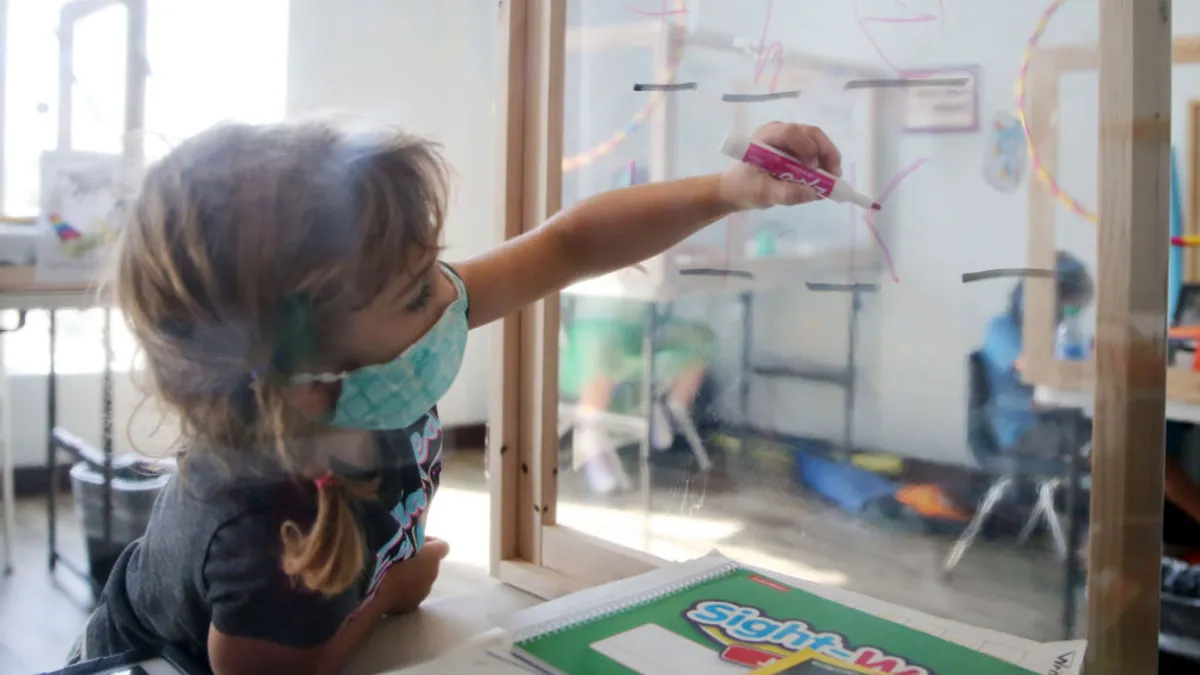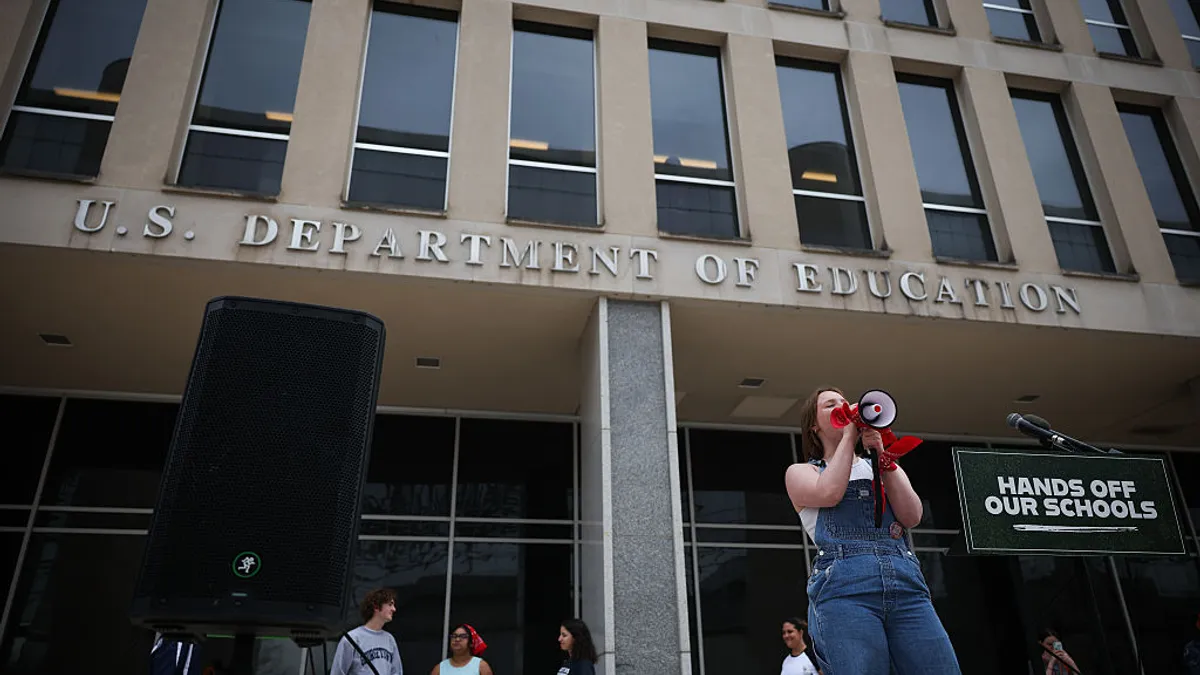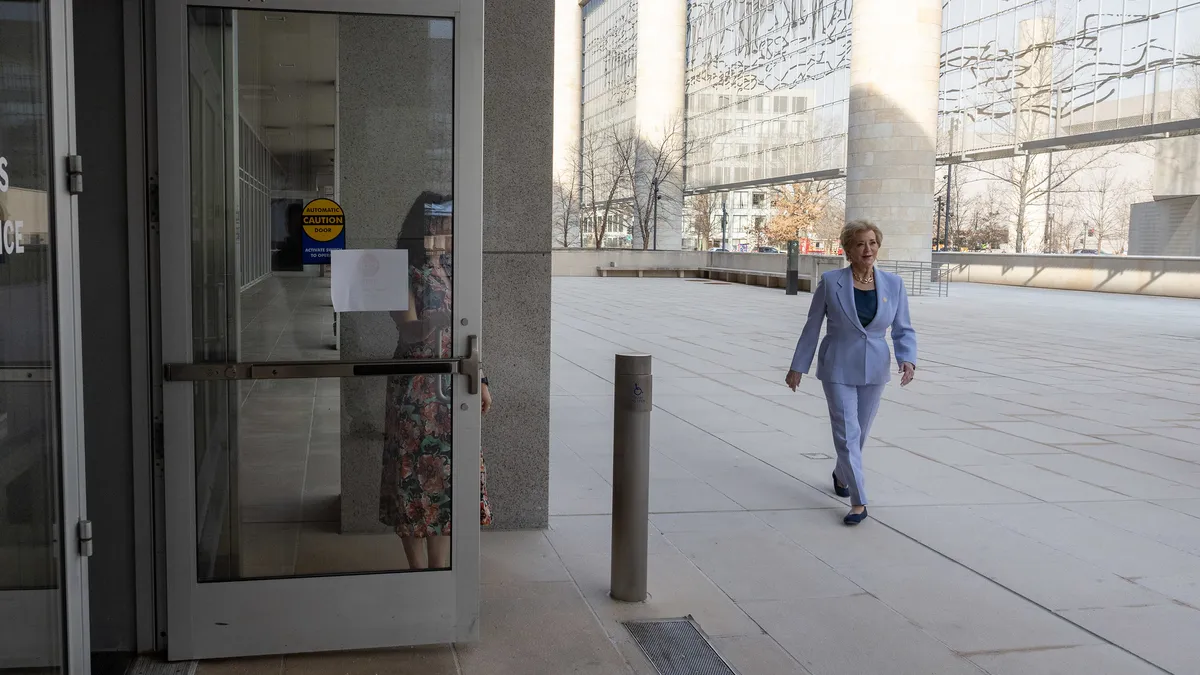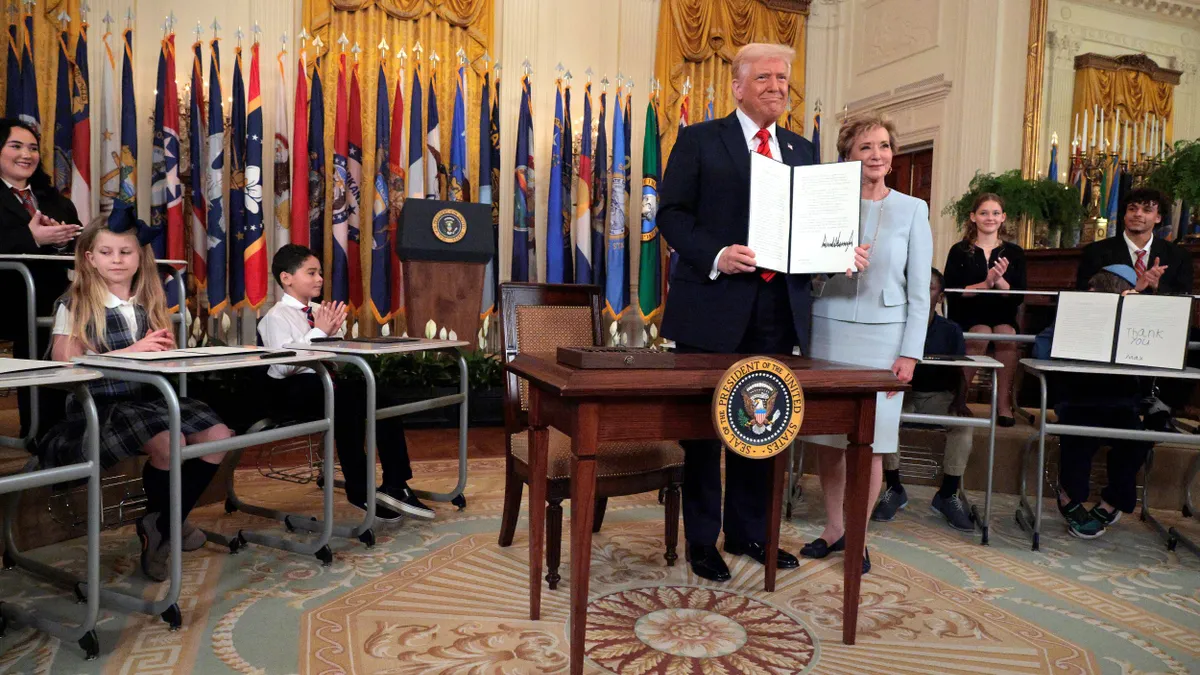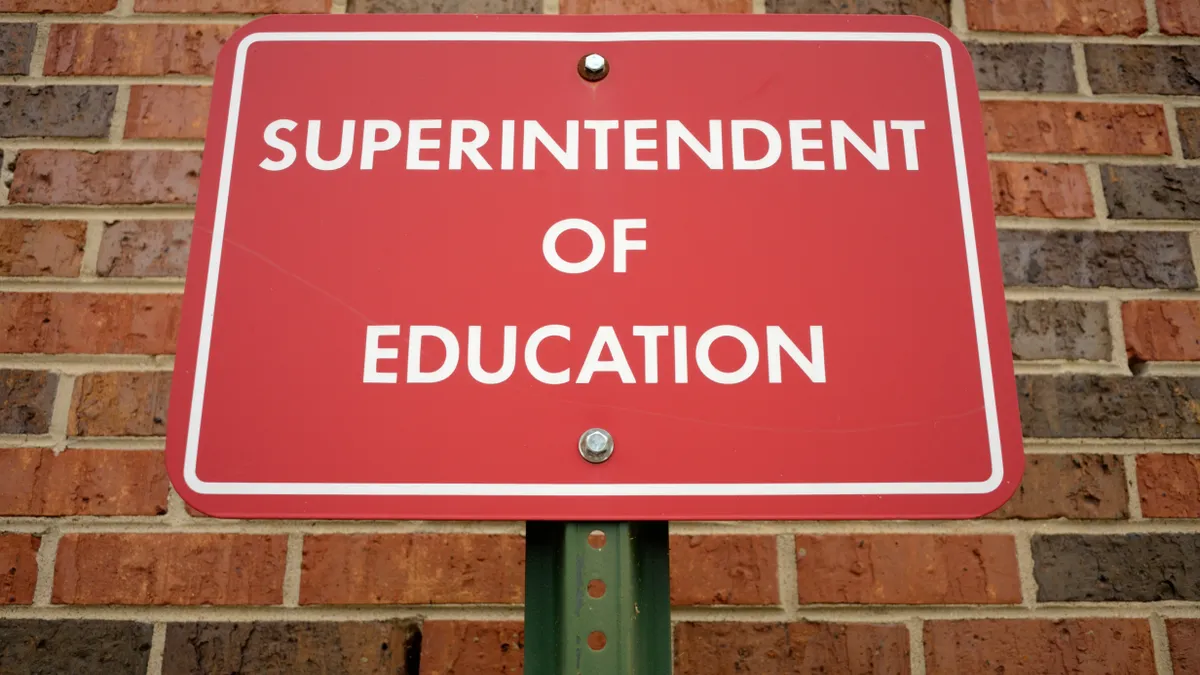Democratic leaders in Congress are demanding the U.S. Department of Education immediately reverse the cancelation of billions of dollars in spending extensions for previously approved pandemic emergency aid approved by Congress.
"This abrupt and chaotic revision of policy is not helpful to students whose states, school districts, or institutions of higher education are uncertain about the Department’s commitments to implementing federal funding designed to support students," said the lawmakers’ April 7 letter. Spearheading the call were Democratic leaders on the Senate and House appropriations and education committees.
Just after 5 p.m. ET on Friday, March 28, U.S. Education Secretary Linda McMahon sent a letter to state education leaders, saying the Education Department was moving up the American Rescue Plan extended spending deadline from March 30, 2026, to that same day.
"Extending deadlines for COVID-related grants, which are in fact taxpayer funds, years after the COVID pandemic ended is not consistent with the Department's priorities and thus not a worthwhile exercise of its discretion," McMahon's letter said.
The one-page letter did offer states an opportunity to continue to extend spending by reapplying for Education Department approvals on a per-contract basis.
As a result, state and district leaders nationwide had to strategize a response to the sudden halt of previously approved spending extensions for the Elementary and Secondary School Emergency Relief fund. The Education Department had approved extension requests for 41 states, Puerto Rico and the District of Columbia under the American Rescue Plan’s ESSER allocation.
"Maybe the new approval process will allow the department to have a higher confidence rate that these funds are being spent on activities like tutoring that ensure academic recovery."

Narric Rome
Managing director of federal and state policy for Accelerate
Although most states asked for and received ARP-ESSER spending extensions, the amount of funding earmarked for the longer spending deadline is small. Nationally, only about 2% of the $201.3 billion in total funds remained unspent from the three COVID relief allocations for public and private schools, states, and supports for students experiencing homelessness, as of February.
The regular spending deadline for ARP-ESSER’s $121.9 billion in funds was Jan. 28, and districts had to obligate — or have commitments for spending the money — by Sept. 30, 2024. Unused ESSER funds would be reclaimed by the federal government.
In late February, the Education Department told K-12 Dive that about $2.5 billion in ARP-ESSER funds remained to be spent by districts in states with extensions. Additionally, about $433 million was left to be spent by states under ARP's Emergency Assistance to Non-Public Schools allocation.
'COVID is over'
Some states, which made the extension requests on behalf of districts, vowed to fight back. The New York State Department of Education, which had planned late liquidation for $79 million, was preparing legal action, according to the New York State United Teachers union.
Michigan State Superintendent Michael Rice said the state could be out more than $40 million as a result of the spending extension reversal. In a statement, Rice said 27 school districts across the state had been preapproved for spending extensions. The planned projects included HVAC systems, as well as boilers and windows, Rice said.
"Without the promised March 2026 date for federal reimbursement requests, districts may be forced to reduce instructional expenditures for students, diminish savings, or both to honor these contracts," Rice said.
COVID is over. ED will consider all appeals for funding that are directly related to students’ COVID learning loss recovery.
— ED Press Secretary (@EDPressSec) April 1, 2025
MA even states in their own press release they want this money for BUILDINGS, not learning recovery.
Massachusetts Gov. Maura Healey says the state was depending on about $106 million in spending extensions. "This action is jeopardizing mental health care and math tutoring for our students, as well as projects that are already underway to enhance school security and ensure that the air in our school buildings is clean," Healey said in a statement.
The activities the extended funds were targeting include academic supports, mental health services, professional development for educators, and building upgrades across 20 school districts, according to the statement.
But an X post on April 1 by the Ed Press Secretary account said, "COVID is over. ED will consider all appeals for funding that are directly related to students’ COVID learning loss recovery. MA even states in their own press release they want this money for BUILDINGS, not learning recovery."
A reversal on spending extensions
AASA, The School Superintendents Association, and other education administrative groups had pleaded with the Biden administration as K-12 spending deadlines for earlier ESSER allocations approached. The organizations cited lingering impacts from pandemic-related school closures, supply chain disruptions and workforce shortages as reasons for a longer spending runway.
Specifically, the organizations were concerned about a longer spending timeline for ARP-ESSER, which Congress funded at $121.9 billion. In total, schools, districts and states received $189.5 billion in ESSER funds.
In May 2022, the Education Department announced a process where it would consider those requests. According to Biden-era Education Department staff in November, all requests were approved.
In February, the Trump administration said states would be responsible for paying remaining ESSER expenses before being reimbursed by the federal government. Previously, states could automatically draw down those federal funds as needed, according to the Education Department.
Now, the department is saying the funds won't be available at all unless states appeal on an individual project basis. The Education Department said the changes are needed to bring more transparency to the process and to ensure taxpayer funds are used appropriately.
But the changing instructions have many state and local leaders, vendors and education finance experts wondering how states and districts will proceed — and if the extensions aren't honored, how local or state governments can fill the budget gaps.
Narric Rome, managing director of federal and state policy for Accelerate, a nonprofit that supports sustainable high-impact tutoring in public schools, said ESSER funds have been critical for pandemic learning recovery.
Accelerate helps states scale high-impact tutoring programs, some of which have been supported in part with ESSER dollars. He said the impact of the Education Department's changing direction on ESSER spending extensions is unknown, but tutoring leaders are hopeful states will seek approvals under the new process.
"Maybe the new approval process will allow the department to have a higher confidence rate that these funds are being spent on activities like tutoring that ensure academic recovery," Rome said.
But some say the spending extensions shouldn't have been granted in the first place. Lindsey Burke, director of the Center for Education Policy at the conservative Heritage Foundation, wrote in a piece published on The Daily Signal that "half a decade on from the pandemic, schools should not still be contemplating how to spend the windfall Congress appropriated as a temporary measure, ostensibly designed to mitigate learning loss."
Burke added, “The clearest evidence that the COVID-19 bonus cash didn’t help students was the most recent National Assessment of Educational Progress results, which were heartbreaking.”
The 2024 NAEP scores showed 4th and 8th grade reading and math scores below pre-pandemic 2019 performances.
Considering the next steps
Elleka Yost, director of advocacy and research at the Association of School Business Officials International, said, "Changing the requirements while the money is already committed has put states and districts in a tough spot."
The uncertainty is causing some states to pause projects. The Kansas State Department of Education, in an April 3 statement, said it directed contracted service providers to pause all tasks dependent on COVID emergency funds. The state said it had $22.6 million remaining in spending extensions.
"This unprecedented action undermines the careful financial planning of school districts across North Carolina and threatens critical programs supporting students."

North Carolina state education leaders in a joint statement
Education leaders in North Carolina asked McMahon to reconsider the funding pullback, saying the move "threatened the financial integrity" of four school districts in the state.
"This unprecedented action undermines the careful financial planning of school districts across North Carolina and threatens critical programs supporting students," said an April 3 joint letter from the state's superintendent and chair of the state board of education.
Virginia state education officials said in an April 3 communication with superintendents and chief financial officers that they were working with 15 districts impacted by the ESSER spending extension reversal. The state is also planning to appeal to the Education Department to continue state-level projects, saying it was a top priority.
Edunomics Lab at Georgetown University has been tracking the pace of COVID aid spending at the district and state levels. Edunomics Lab Director Marguerite Roza said what would be most helpful to the public is if districts, states and the Education Department were more transparent about what public and private school projects got spending extensions and why.
"It's been really hard to find out which districts and which projects are affected" by the Education Department's policy change, Roza said.



